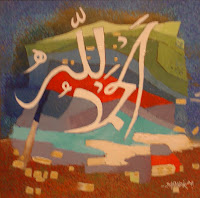


reviu pameran
Dalam sebuah pameran khas yang berakhir baru-baru ini, karya dari tiga seniman besar Singapura telah dipamerkan dalam satu ruang. Karya-karya dari seniman Allahyarham Hj Sulaiman Suhaimi, Allahyarham Mohammad Din Mohammad dan juga dari S Mohdir telah menjadi tatapan ramai di Galeri Taman Warisan Melayu sejak bulan ramadhan yang lalu. Julung-julung kali, karya-karya khat atau kaligrafi Islam mereka disatukan dalam sebuah pameran. Pameran ini telah berlangsung selama sebulan sejak bulan ramadah yang lalu.
Gabungan hebat sebegini pun jarang-jarang berlaku semasa hayat dua pelukis yang sudahpun menjadi almarhum. Tiga seniman ini berkarya dengan teknik pengolahan yang berbeza-beza dalam kaligrafi Islam. Mereka mempunyai pendekatan yang berlainan dan cara mereka mengilhamkan lukisan juga berlainan.
S Mohdir, salah seorang pengasas APAD (Angkatan Pelukis Aneka Daya) yang masih berkarya menampakkan teknik yang berlapis-lapis dan warna bertindih-menindih. Karya khat S Mohdir berdimensi dan tetap utuh ditelan waktu. S Mohdir yang sudahpun menjangkau 70’han tahun merasakan melukis ialah caranya untuk merehatkan fikiran. Sejauh ini, pelukis veteran ini masih belum mahu bersara dalam dunia seni halus ini.
Sebagai seorang guru pesara, S Mohdir masih secara konsisten mengilhamkan karya-karya yang mantap dan berseni. Sememangnya beliau merupakan seniman yang penuh pengalaman dan sering menghasilkan karya-karya yang segar. Dalam pemeran ini, S Mohdir menggabungkan seni khat dengan seni halus.
Seorang lagi pelukis, Hj Sulaiman Suhaimi, yang baru meninggalkan kita beberapa bulan lalu, merupakan seorang seniman dari generasi pertama. Teknik dan caranya menghasilkan karya-karya khat berbeza dengan S Mohdir dan Mohammad Din Mohammad. Hj Sulaiman mendalami seni khat ketika beliau pulang dari mengerjakan umrah satu ketika dahulu. Setelah mendalami seni khat, Hj Sulaiman juga telah mengadakan bengkel seni khat di rumahnya.
Hj Sulaiman pernah menjadi guru dan inspektor sekolah. Gaya dan tekniknya agak teliti dan tenang. Karya-karya khatnya telah banyak dijadikan hiasan untuk kalendar beberapa buah masjid untuk pengumpulan dana. Warna-warna khat Hj Sulaiman agak suram, namun teks ataupun surah keIslaman adalah keutamannya. Cara beliau menyampaikan maksud dalam karya juga ketara perbezaannya. Kehilangan beliau dipersada seni amat dirasakan.
Karya-karya Mohammad Din Mohammad juga telah mengisi ruang galeri Taman Warisan Melayu. Beliau telah meninggalkan kita pada Mei tahun lalu, dan kebelakangan ini, karya-karya beliau semakin sering diperkatakan dan pemikiran seninya juga akan dijadikan bahan penyelidikkan. Allahyarham telah meninggalkan kita dalam lingkungan 50’han. Beliau telah meninggalkan khazanah lukisan khat yang agak banyak dan ada yang dipamerkan di galeri kelolaan keluarga armarhum di Durian Tunggal, Melaka.
Karya-karya Mohammad Din juga amat berbeza tekniknya dan persembahannya. Dengan menggunakan tapak tangan, jari-jemari serta warna yang langsung dari tiub, lukisan khatnya kelihatan lebih agresif dan spontan. Warna-warna dalam khatnya berbagai-bagai. Karya monokrom juga berwarna-warni menjadi pilihan utama pengkarya.
Ada karya yang hanya digunakan Alif, Ba, Ta dan ada karya yang gunakan ayat-ayat ringkas dari Al-Quran. Sewaktu hayatnya, Armarhum pernah mengadakan pameran solonya selain di Perancis dan Turki, ada banyak lagi pameran pernah disertainya.
Namun, ketiga-tiga seniman mempunyai matlamat dan arah yang satu. Mereka bersatu dalam kaligrafi Islam. Mereka inginkan kalimah-kalimah keIslaman disebarkan melalui seni. Melalui seni khat, kita seolah-olah berzikir mengucapkan kata-kata untuk mengingati Allah. Semestinya, mengEsakan Allah dan menyatakan kesyukuran dalam bentuk Alhamdulillah menjadikan pemikiran mereka menjadi satu.
Syabas kepada Taman Warisan Melayu kerana inisiatif mereka mengadakan pameran dan juga demonstrasi seni khat sepanjang Ramadan dan Syawal ini.
Gabungan hebat sebegini pun jarang-jarang berlaku semasa hayat dua pelukis yang sudahpun menjadi almarhum. Tiga seniman ini berkarya dengan teknik pengolahan yang berbeza-beza dalam kaligrafi Islam. Mereka mempunyai pendekatan yang berlainan dan cara mereka mengilhamkan lukisan juga berlainan.
S Mohdir, salah seorang pengasas APAD (Angkatan Pelukis Aneka Daya) yang masih berkarya menampakkan teknik yang berlapis-lapis dan warna bertindih-menindih. Karya khat S Mohdir berdimensi dan tetap utuh ditelan waktu. S Mohdir yang sudahpun menjangkau 70’han tahun merasakan melukis ialah caranya untuk merehatkan fikiran. Sejauh ini, pelukis veteran ini masih belum mahu bersara dalam dunia seni halus ini.
Sebagai seorang guru pesara, S Mohdir masih secara konsisten mengilhamkan karya-karya yang mantap dan berseni. Sememangnya beliau merupakan seniman yang penuh pengalaman dan sering menghasilkan karya-karya yang segar. Dalam pemeran ini, S Mohdir menggabungkan seni khat dengan seni halus.
Seorang lagi pelukis, Hj Sulaiman Suhaimi, yang baru meninggalkan kita beberapa bulan lalu, merupakan seorang seniman dari generasi pertama. Teknik dan caranya menghasilkan karya-karya khat berbeza dengan S Mohdir dan Mohammad Din Mohammad. Hj Sulaiman mendalami seni khat ketika beliau pulang dari mengerjakan umrah satu ketika dahulu. Setelah mendalami seni khat, Hj Sulaiman juga telah mengadakan bengkel seni khat di rumahnya.
Hj Sulaiman pernah menjadi guru dan inspektor sekolah. Gaya dan tekniknya agak teliti dan tenang. Karya-karya khatnya telah banyak dijadikan hiasan untuk kalendar beberapa buah masjid untuk pengumpulan dana. Warna-warna khat Hj Sulaiman agak suram, namun teks ataupun surah keIslaman adalah keutamannya. Cara beliau menyampaikan maksud dalam karya juga ketara perbezaannya. Kehilangan beliau dipersada seni amat dirasakan.
Karya-karya Mohammad Din Mohammad juga telah mengisi ruang galeri Taman Warisan Melayu. Beliau telah meninggalkan kita pada Mei tahun lalu, dan kebelakangan ini, karya-karya beliau semakin sering diperkatakan dan pemikiran seninya juga akan dijadikan bahan penyelidikkan. Allahyarham telah meninggalkan kita dalam lingkungan 50’han. Beliau telah meninggalkan khazanah lukisan khat yang agak banyak dan ada yang dipamerkan di galeri kelolaan keluarga armarhum di Durian Tunggal, Melaka.
Karya-karya Mohammad Din juga amat berbeza tekniknya dan persembahannya. Dengan menggunakan tapak tangan, jari-jemari serta warna yang langsung dari tiub, lukisan khatnya kelihatan lebih agresif dan spontan. Warna-warna dalam khatnya berbagai-bagai. Karya monokrom juga berwarna-warni menjadi pilihan utama pengkarya.
Ada karya yang hanya digunakan Alif, Ba, Ta dan ada karya yang gunakan ayat-ayat ringkas dari Al-Quran. Sewaktu hayatnya, Armarhum pernah mengadakan pameran solonya selain di Perancis dan Turki, ada banyak lagi pameran pernah disertainya.
Namun, ketiga-tiga seniman mempunyai matlamat dan arah yang satu. Mereka bersatu dalam kaligrafi Islam. Mereka inginkan kalimah-kalimah keIslaman disebarkan melalui seni. Melalui seni khat, kita seolah-olah berzikir mengucapkan kata-kata untuk mengingati Allah. Semestinya, mengEsakan Allah dan menyatakan kesyukuran dalam bentuk Alhamdulillah menjadikan pemikiran mereka menjadi satu.
Syabas kepada Taman Warisan Melayu kerana inisiatif mereka mengadakan pameran dan juga demonstrasi seni khat sepanjang Ramadan dan Syawal ini.







